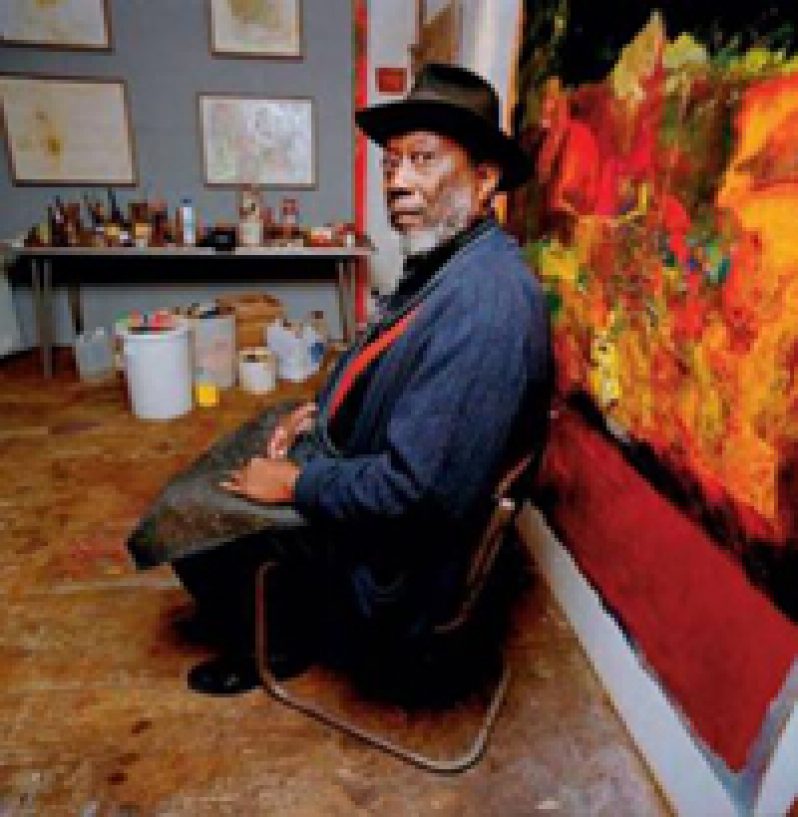THE proof of Bowling’s gradual manifestation of Guyanese identity in his painting arises with his first individual approach to a theme or topic uniquely his own around 1966 – 67.
The fact that Bowling took a good 13 years before arriving at this important point, evidence of which Gooding, in his monograph on the painter adequately provides, perhaps also encourages the idea that his entire formation and identity as a painter was created by Britain, and in Britain, after he came to London in 1953 at age nineteen.
However, he was not an intellectual student pursuing tutoring, like a number of other British Guianese immigrants of that time who became expatriate artists. For years, his life in Britain was quite unsettled and insecure, typically bohemian, but as befits any serious artist-to-be, rather than a mere dilettante, he read and paid deep attention to high-quality literature and paintings, old and new.
By the encouragement of educated persons, especially artists he met, he began to paint. These first works are quite amateur, unfocused, and simply exercises in various techniques and styles being explored at the time by Pop and figurative British artists like David Hockney, R.B. Kitaj, Peter Blake and Francis Bacon, all of whom Bowling came to know well.
Individuality By 1966, what began to emerge in Bowling’s new paintings was the first evidence that an underlying theme and obsession, rooted in Guyana as an intuitive and memorial source of the artist’s identity, would overtake and harness all the technical and stylistic considerations he had absorbed in Britain so far, leading to topics mostly far removed from any acquired foreign identity that was defined by the mundane concerns of the painter’s metropolitan immigration and residence.
By 1966, what began to emerge in Bowling’s new paintings was the first evidence that an underlying theme and obsession, rooted in Guyana as an intuitive and memorial source of the artist’s identity, would overtake and harness all the technical and stylistic considerations he had absorbed in Britain so far, leading to topics mostly far removed from any acquired foreign identity that was defined by the mundane concerns of the painter’s metropolitan immigration and residence.
If we take a look at Bowling’s 1966 – 67 London paintings with the super-imposed screen-print of a Guyanese classic wooden house, there is no mistaking the artist’s first achievement of an original format, both in content and style that is synonymous with a powerful awareness of his Guyanese origin, rooted in both nationality and culture.
‘Barticabather’
‘Barticabather’ of 1966 – 67 is one such brilliant painting in which a voluptuous naked woman, whose head, thrown back under a raised calabash of water, is painted in a blur, so that we cannot decide on her specific racial identity, except that she is quite tropical or Creole, and not a British or European woman.
Such a scene is, or was, quite common all over Guyana since Ancient times, while the screen-print of the classic wooden Guyanese house pasted to the canvas above the bather’s head completes the artist’s picture of his remembered specific native identity.
‘My Guyana’ of 1966 – 67 is also a profound example of the painter’s awareness of his specific Guyanese origin. This painting’s central lower image is of a blurred female figure lifting a type of wooden chair quite common in Guyana, as though exiting the painting towards us.
The chair is clearly related to the house, and suggests it has been taken from it. The process of something and someone moving from one place to another is being suggested, yet the location being left is totally present, while the intended new location of person and chair remains unknown or ambiguous.
This sort of visual signification, mastered early by Bowling, proved his originality, and hints that his structured approach to painting was influenced by absorbing the transformative texts of modern creative writing which he avidly consumed.
Whether Bowling intended it or not, his combination of figuration with abstract fields of colour in this specific painting signifies both the subjective and historical experience of Guyanese identity. The upper blue half of the painting upon which the image of the classic Guyanese wooden house rests can signify the longer Dutch colonial founding history of Guyana that is officially associated with the colour blue, while the lower half’s red, against which the figure is carrying the supportive chair, is officially associated with the Red Coat history of Guyana’s (Essequibo, Demerara, and Berbice) later British colonial succession.
These transitions are unified by the human figure and the chair, both of which are related to the culturally unified architecture of the classic Guyanese house. The painting, ‘My Guyana’, therefore, smoothly contains and presents as one image both the historical and subjective human transitions experienced by Guyanese identity.
Perspective of identity
Though the technical styles of blurred figures against hard-edge geometric backgrounds in these early Bowling paintings no doubt reveal the influence of a few British contemporary painters who emerged in the 1960s, Bowling has subjected their technical lessons to his Guyanese theme and topic, thus reflecting the continued founding give-and-take historical relationship that has long been part of his cosmopolitan cultural inheritance and heritage as a Guyanese.



.jpg)









